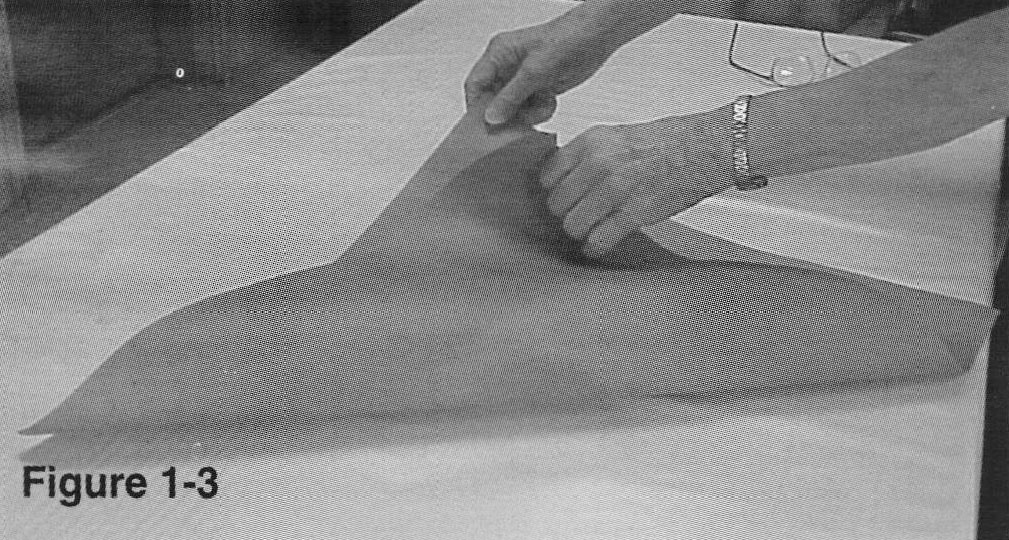Fundamental Procedures for Enamelists
4 Minute Read
Mixing Dry Granular Material
Frequently, we are asked how to mix two or more dry materials, such as two transparent enamels, to obtain a third color. We always recommend the age-old method used by the ancients. It is excellent for small batches, simple, and the equipment is easy to find - a piece of paper and a flat surface.
Figure 1-1 shows a piece of brown wrapping paper laying on a table with a small pile of 80 mesh transparent clear enamel, and a smaller amount of 80 mesh transparent dark blue in the center. These have been selected for teaching purposes. Normally, when mixing transparents, colors closer to the same strength would be selected.
Figure 1-2 shows the upper right corner is being rolled toward the lower left corner. This is done in a way to cause the material to roll, not slide. Continue rolling the material toward the left hand, stop as the material approaches the edge of the paper. Take the lower left corner of the paper and roll the material to the upper right corner, Figure 1-3. Repeat this rolling from corner to corner several times, stopping the last roll with the material in the center of the paper, Figure 1-4. The center of the material looks well mixed, while the ends do not. Now, mix in the same manner, using the upper left and lower right corners, until you feel it is well mixed. Stop with the material in the center of the paper, as in Figure 1-5. The mix should appear the same throughout. Continue to mix, alternating the direction of rolling, until you feel confident the two colors are uniformly blended together. A further check is pulling a spatula through the material. as in Figure 1-6, and inspecting the distribution.
Mixing Dry Powder Material
We recommend a different procedure to mix fine powders such as 325 mesh painting flux with ceramic or inorganic pigments. Again, the equipment is minimal and rather easy to obtain. We use a white enamel plate and a flexible spatula. A piece of glass can be used rather than the enamel plate.
- Figure 2-1 shows a small pile of 325 mesh painting flux in one corner. Using a spatula, divide and move a portion of the flux to the center of the plate, Figure 2-2. The size of this portion depends on the amount of pigment you intend to use. Most pigments are quite strong, and in some cases may represent less than 5% of the total batch being mixed. Care must be used to prevent losing the pigment in the larger amount of flux. So, move an amount of flux equal to about twice the amount of pigment you intend to use. Figure 2-3 shows the pigment placed on the center of the flux.
- Mix the pigment and frit in a circular motion with the spatula, as in Figure 2-4. When it looks well mixed, scrape it into a row, as in Figure 2-5.
- Rotate the mixing plate counter-clockwise 90°. Using the spatula, pull (spread or smear) the mixed powder down using several strokes, Figure 2-6. When it is all pulled down, scrape it into a row, as in Figure 2-7.
- Repeat step 3 at least 3 times.
- When it looks well mixed, and prior to scraping it into a row, add a portion of the reserve pile of flux. Use the spatula to sprinkle it onto the mixture of pigment and flux, Figure 2-8. Mix as in steps 2, 3 and.4, until all of the flux has been added and well mixed.
Mixing Powder with Painting Medium
Mixing painting colors is no longer a full-day job as in earlier years. Present day colors are well ground. If the glass and pigments are well-mixed as above, there should be no lumps or sizable particles requiring reduction in size.
Place a desired amount of color powder in the center of an enamel or glass palette. Starting near the edge of the pile, add a small amount of medium. Begin to mix slowly and carefully with a straight blade palette knife. A firm but flexible 6″ or 8″ long palette knife with good spring action is ideal.
The motion is circular. Turn the knife over occasionally to insure mixing of any build-up on the blade. Keep pulling in more powder to thicken the mix and adding a small amount of medium as needed. When the whole mixture reaches the consistency of yogurt, do not add more medium, but continue to mix for ten minutes or until thoroughly mixed. The paint should be soft but with sufficient body to retain its shape when pushed to one side of the palette. Test by taking some with a brush and making a few strokes near a corner of the palette. Add more medium or powder and remix to obtain the desired consistency.
You assume all responsibility and risk for the use of the safety resources available on or through this web page. The International Gem Society LLC does not assume any liability for the materials, information and opinions provided on, or available through, this web page. No advice or information provided by this website shall create any warranty. Reliance on such advice, information or the content of this web page is solely at your own risk, including without limitation any safety guidelines, resources or precautions, or any other information related to safety that may be available on or through this web page. The International Gem Society LLC disclaims any liability for injury, death or damages resulting from the use thereof.
The All-In-One Jewelry Making Solution At Your Fingertips
When you join the Ganoksin community, you get the tools you need to take your work to the next level.
Trusted Jewelry Making Information & Techniques
Sign up to receive the latest articles, techniques, and inspirations with our free newsletter.
